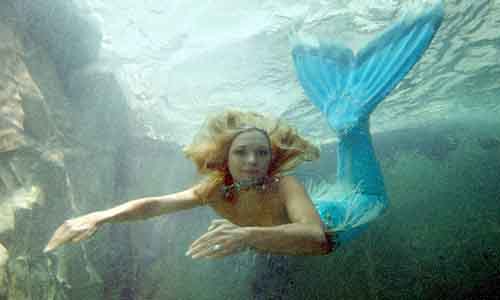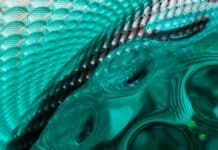Mermaids: Strange half-human, half-fish creatures that live in the sea, mermaids have been described as expressions of the love goddess Aphrodite, harbingers of doom, sexual temptresses luring sailors on to the rocks, as well as symbols of man’s unity with Nature. MATT WINGETT looks at the history of mermaids and describes why one of them inspired his novella “Turn The Tides Gently”.

There is something strangely “other” about the whole idea of mermaids. These ethereal, other-worldly creatures haunt the imagination of many of the world’s cultures. They are, supposedly, inspired by sightings of manatees and dugongs by sailors who had apparently been so long at sea that they’d forgotten what women actually looked like.
Alongside this prosaic idea of myopic mariners accounting for the origins of mermaids are other much more interesting suggestions. Suggestions that show the power of the human imagination to take an idea and really give it legs. Or not, as the case may be.
The earliest “mermaid-style” story predates our short-sighted sailors by several thousand years. Around 1,000 BC in Assyria, a story was told of the goddess Atargatis who loved a human shepherd and accidentally killed him. Stricken with grief, she threw herself into a lake and decided to take on the shape of a fish. But, so the legend goes, her divine beauty could not be hidden by the waters, and she appeared as a mermaid – complete with beautiful top half, and something distinctly fishy underneath. (No jokes, please, gentlemen!)
Thus we have, from the very beginning, several of the motifs that were to colour many of the mermaid tales to follow: a sub-aquarian intruder who is romantically engaged, beautiful – and deadly.
Women and water, it appears, are dangerous.
In Greek mythology, we see several examples of these dangers-to-shipping such women represented. The Sirens, though not, strictly-speaking, mermaids, were beautiful women who lured sailors on to the rocks with their mesmerising singing. And Jason and the Argonauts landed on an island to get provisions, only to have one of their number, Hylas, dragged beneath a lake by water-nymphs. It is a scene brilliantly captured by Waterhouse, in his painting Hylas And The Nymphs.
Somehow, these non-mermaid tales became identified with mermaids, so that throughout the Middle Ages, mermaids took on a rather sinister hue. But not always. In British and Irish mythology, a mermaid might turn up at a homestead to provide special medicine to the sick, just as much as to bring bad luck. But overall, for the mediaeval mind, the mermaid was to be avoided.
The fortunes of the mermaid began to change with stories such as that of The Little Mermaid, by Hans Christian Andersen, telling of a psychologically real protagonist who is desperately in love with a human. She manages to form legs, but at the cost of feeling like she is walking on broken glass when she is ashore. Andersen begins the process of the rehabilitation of the mermaid to something that we can recognise as like ourselves, yet different.
By the modern day, the mermaid has become something quite different again. Alongside Pirates of the Caribbean IV’s depiction of mermaids as beautiful sea-vampires come to kill sailors for their own evil ends there is something far more beautiful and benign.
Mermaids Today
A large community of mermaids, mainly in the US, has taken the mermaid motif as a means of symbolising humankind’s symbiosis with Nature. Being often very beautiful and wearing skimpy clothing, these mermaids certainly make people take notice of their message. But don’t let the showbiz fool you – these modernday mermaids are really dedicated to the cause of ecology and saving the planet. I have had some great talks with these people, and their energy and enthusiasm for what they do really shines through.
One notable case is that of Hannah Mermaid, who has swum with dolphins being slaughtered by Japanese fishermen – risking mutilation from their boats’ motors to make her point. You can see more about Hannah, here.
It’s a fascinating and never-ending tale (or tail!) – as each generation makes its own myths from the mermaid story, and one that I find really compelling.
That’s why I couldn’t resist including a mermaid in one of my own supernatural stories.
My novella incorporating the mermaid idea, Turn The Tides Gently, uses the mermaid motif in a different way again, adding a new layer of mystery to the story’s lost and confused central character, who can’t quite tell if she is real.
That’s the great fun to be had with such strange concepts as mermaids – you can turn them into whatever you like. And so, I look forward to seeing which way the tides of taste take the mermaid myth next!
Discover the Mermaid of Zennor, Cornwall’s mysterious maritime tale!
Read Scottish Mermaid Real Life Tales





It is worth mentioning the interesting take that H.P.Lovecraft had on mer-people….
read the Shadow over Innsmouth or Dagon to see what I mean
I grew up with an anime version of the little mermaid which is worth seeing as it matches Hans’ tale – love the Denmark statue. Mariiiiiiiiiina!